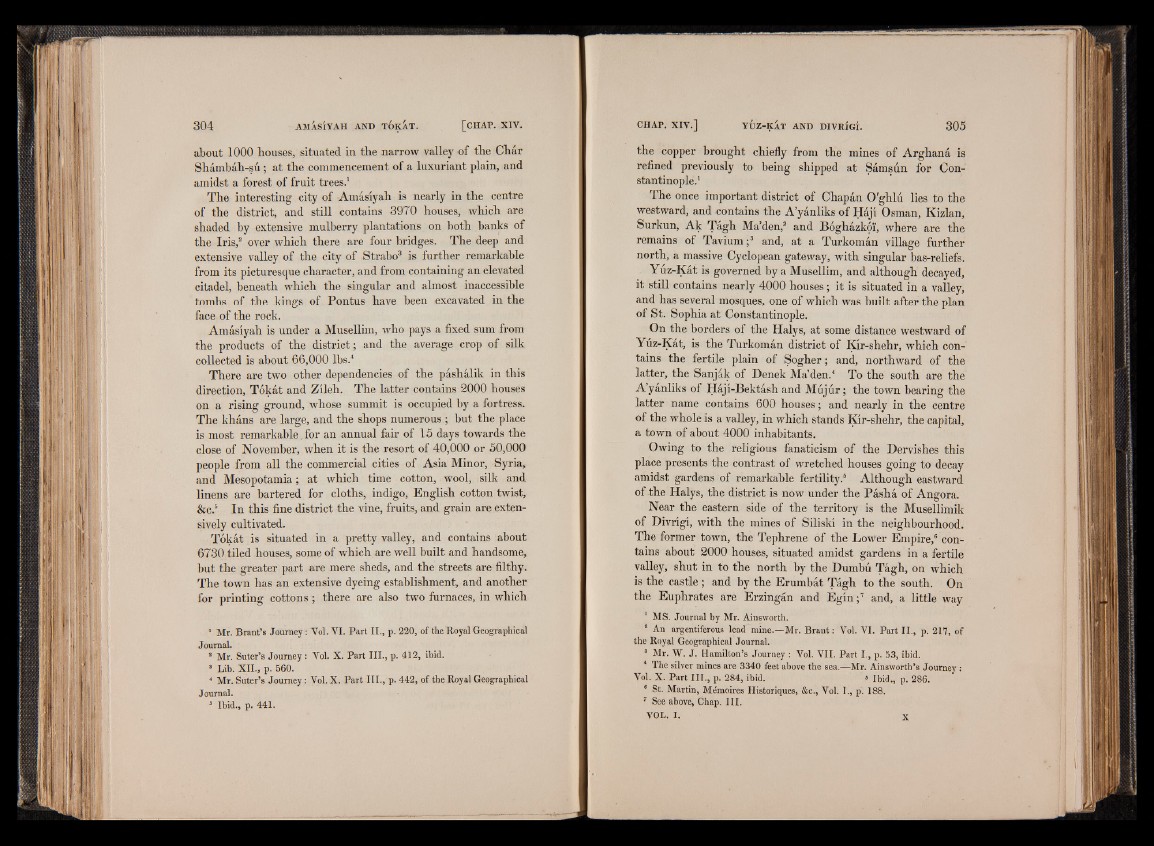
about 1000 bouses, situated in the narrow valley of tbe Char
Shambah-su; at the commencement of a luxuriant plain, and
amidst a forest of fruit trees.1
The interesting city of Amasiyah is nearly in the centre
of the district, and still contains 3970 houses, which are
shaded by extensive mulberry plantations on both banks of
the Iris,2 over which there are four bridges. The deep and
extensive valley of the city of Strabo3 is further remarkable
from its picturesque character, and from containing an elevated
citadel, beneath which the singular and almost inaccessible
tombs of the kings of Pontus have been excavated in the
face of the rock.
Amasiyah is under a Musellim, who pays a fixed sum from
the products of the district; and the average crop of silk
collected is about 66,000 lbs.4
There are two other dependencies of the pashalik in this
direction, Tokat and Zileh. The latter contains 2000 houses
on a rising ground, whose summit is occupied by a fortress.
The khans are large, and the shops numerous ; but the place
is most remarkable, for an annual fair of 15 days towards the
close of November, when it is the resort of 40,000 or 50,000
people from all the commercial cities of Asia Minor, Syria,
and Mesopotamia; at which time cotton, wool, silk and
linens are bartered for cloths, indigo, English cotton twist,
&c.5 In this fine district the vine, fruits, and grain are extensively
cultivated.
Tokat is situated in a pretty valley, and contains about
6730 tiled houses, some of which are well built and handsome,
but the greater part are mere sheds, and the streets are filthy.
The town has an extensive dyeing establishment, and another
for printing cottons; there are also two furnaces, in which
1 Mr. Brant’s Journey: Vol. VI. Part II., p. 220, of the Royal Geographical
Journal.
8 Mr. Suter’s Journey : Vol. X. Part III., p. 412, ibid.
8 Lib. XII., p. 560.
4 Mt. Suter’s Journey: Vol. X. Part III., p. 442, of the Royal Geographical
Journal.
8 Ibid., p. 441.
the copper brought chiefly from the mines of Arghana is
refined previously to being shipped at Samsun for Constantinople.
1
The once important district of Chapan O'ghlu lies to the
westward, and contains the A’yanliks of Haji Osman, Kizlan,
Surkun, Ak Tagh Ma’den,2 and Boghazkoi, where are the
remains of Tavium ;3 and, at a Turkoman village further
north, a massive Cyclopean gateway, with singular bas-reliefs.
Yuz-Kat is governed by a Musellim, and although decayed,
it still contains nearly 4000 houses; it is situated in a valley,
and has several mosques, one of which was built after the plan
of St. Sophia at Constantinople.
On the borders of the Halys, at some distance westward of
Yuz-Kat, is the Turkoman district of Kir-shehr, which contains
the fertile plain of Sogher; and, northward of the
latter, the Sanjak of Denek Ma’den.4 To the south are the
Ayanliks of Haji-Bektash and Mujur; the town bearing the
latter name contains 600 houses; and nearly in the centre
of the whole is a valley, in which stands Kir-shehr, the capital,
a town of about 4000 inhabitants.
Owing to the religious fanaticism of the Dervishes this
place presents the contrast of wretched houses going to decay
amidst gardens of remarkable fertility.5 Although eastward
of the Halys, the district is now under the Pasha of Angora.
Near the eastern side of the territory is the Musellimik
of Divrigi, with the mines of Siliski in the neighbourhood.
The former town, the Tephrene of the Lower Empire,6 contains
about 2000 houses, situated amidst gardens in a fertile
valley, shut in to the north by the Dumbu Tagh, on which
is the castle ; and by the Erumbat Tagh to the south. On
the Euphrates are Erzingan and Egin;7 and, a little way
1 MS. Journal by Mr. Ainsworth.
8 An argentiferous lead mine.—Mr. Brant: Vol. VI. Part II., p. 217, of
the Royal Geographical Journal.
8 Mr. W. J. Hamilton’s Journey : Vol. VII. Part I., p. 53, ibid.
* The silver mines are 3340 feet above the sea.—Mr. Ainsworth’s Journey :
Vol. X. Part III., p. 284, ibid. * Ibid., p. 286.
‘ St. Martin, Memoires Historiques, &c., Vol. I., p. 188.
7 See above, Chap. III.
VOL. I. x